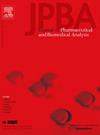采用液相色谱-串联质谱法同时定量测定三甲胺(TMA)和三甲胺-N-氧化物(TMAO)时为减少背景干扰而进行的衍生化处理
IF 3.1
3区 医学
Q2 CHEMISTRY, ANALYTICAL
Journal of pharmaceutical and biomedical analysis
Pub Date : 2024-09-20
DOI:10.1016/j.jpba.2024.116480
引用次数: 0
摘要
三甲胺(TMA)和三甲胺-N-氧化物(TMAO)在动物、植物、真菌和细菌等多种生物体内的许多生化过程中发挥着至关重要的作用。研究表明,这些代谢物与心血管和肾脏疾病有关;不过,也有新的证据表明它们具有保护作用。由于这些争议以及生物样本中这些代谢物的共存,准确量化这些代谢物至关重要,以便将它们的浓度与各种生理和病理生理条件联系起来,从而阐明它们的潜在作用。我们报告了在未衍生分析物的情况下对 TMA 定量的干扰。我们采用了一种组合样品制备方法,包括用溴乙酸乙酯对样品进行衍生,并使用离子配对试剂(庚烷磺酸钠),从而最大程度地减少了这些干扰,并提高了 TMA 和 TMAO 同时定量的准确度和精密度。TMAO 的线性范围为 0.01 µM - 300 µM,TMA 的线性范围为 0.1 µM - 300 µM。应用该方法后,我们发现雄性小鼠的 TMA 循环浓度(33.1 ± 5.9 µmol/L)比雌性小鼠(8.3 ± 1.39 µmol/L)高 4 倍,而雄性小鼠的 TMAO 水平(7.2 ± 0.4 µmol/L)比雌性小鼠(42.1 ± 4.5 µmol/L)低 6 倍。相比之下,雄性和雌性小鼠结肠组织中的 TMA 和 TMAO 浓度没有显著差异。同时定量 TMA 和 TMAO 的可靠分析方法在促进 TMA 和 TMAO 生物学研究方面具有重要价值。本文章由计算机程序翻译,如有差异,请以英文原文为准。
Derivatization to reduce background interferences for simultaneous quantitation of trimethylamine (TMA) and trimethylamine-N-oxide (TMAO) using liquid chromatography with tandem mass spectrometry
Trimethylamine (TMA) and trimethylamine-N-oxide (TMAO) play a crucial role in many biochemical processes within diverse organisms including animals, plants, fungi and bacteria. Studies have linked these metabolites with cardiovascular and kidney diseases; however, emerging evidence demonstrates their protective properties. Owing to these controversies and co-existence of these metabolites in biological samples, it is crucial to accurately quantify these metabolites to associate their concentrations with various physiological and pathophysiological conditions to elucidate their potential roles. We reported interferences on TMA quantification without derivatizing the analyte. A combined sample preparation method, including sample derivatization with ethyl bromoacetate and use of ion pairing reagent (sodium heptanesulfonate), minimized these interferences and provided improved accuracy and precision for simultaneous quantification of TMA and TMAO. The linearity for TMAO ranged from 0.01 µM to 300 µM and 0.1 µM - 300 µM for TMA. With the application of this method, we reported that the circulating concentrations of TMA was 4 times higher in male mice (33.1 ± 5.9 µmol/L) compared to females (8.3 ± 1.39 µmol/L), whereas TMAO levels were 6 times lower in male (7.2 ± 0.4 µmol/L) than female mice (42.1 ± 4.5 µmol/L). In contrast, concentrations of TMA and TMAO in the colonic tissue did not differ significantly between males and females. The robust analytical method for simultaneously quantifying TMA and TMAO presents a significant value in facilitating investigations on TMA and TMAO biology.
求助全文
通过发布文献求助,成功后即可免费获取论文全文。
去求助
来源期刊
CiteScore
6.70
自引率
5.90%
发文量
588
审稿时长
37 days
期刊介绍:
This journal is an international medium directed towards the needs of academic, clinical, government and industrial analysis by publishing original research reports and critical reviews on pharmaceutical and biomedical analysis. It covers the interdisciplinary aspects of analysis in the pharmaceutical, biomedical and clinical sciences, including developments in analytical methodology, instrumentation, computation and interpretation. Submissions on novel applications focusing on drug purity and stability studies, pharmacokinetics, therapeutic monitoring, metabolic profiling; drug-related aspects of analytical biochemistry and forensic toxicology; quality assurance in the pharmaceutical industry are also welcome.
Studies from areas of well established and poorly selective methods, such as UV-VIS spectrophotometry (including derivative and multi-wavelength measurements), basic electroanalytical (potentiometric, polarographic and voltammetric) methods, fluorimetry, flow-injection analysis, etc. are accepted for publication in exceptional cases only, if a unique and substantial advantage over presently known systems is demonstrated. The same applies to the assay of simple drug formulations by any kind of methods and the determination of drugs in biological samples based merely on spiked samples. Drug purity/stability studies should contain information on the structure elucidation of the impurities/degradants.

 求助内容:
求助内容: 应助结果提醒方式:
应助结果提醒方式:


